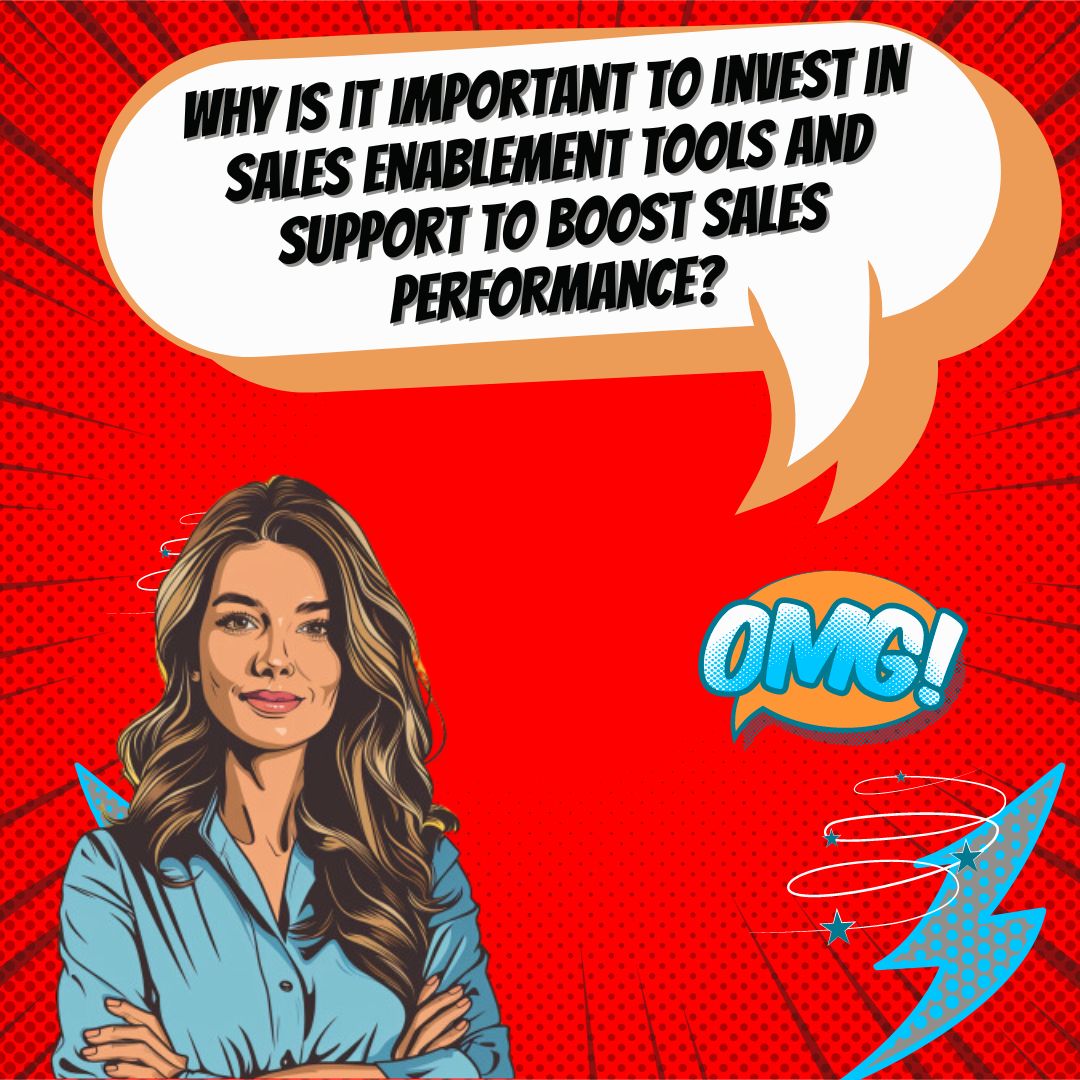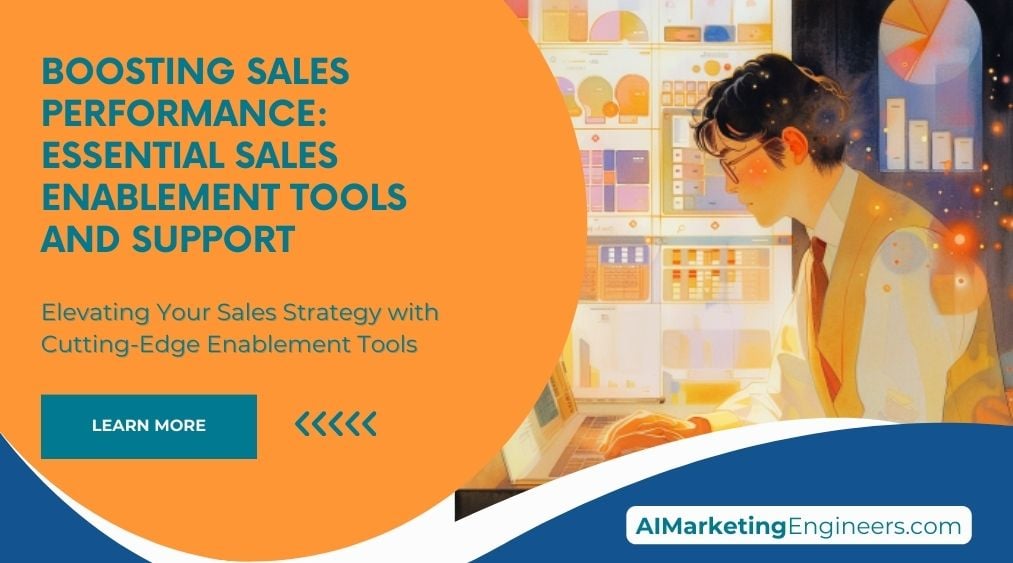Key Takeaways
✅ Integration and Analytics are Key Features: Select sales enablement tools that mesh well with your current tech setup, like CRM systems, to let information flow without hitches. Look for tools that shine a light on your sales data, providing crucial insights on performance metrics, content effectiveness, and customer interactions.
✅ Choosing the Right Tools: It's not just about having tools; it's about having the right toolkit. Think about ease of integration, analytical depth, security, content generation capacities, user-friendly design, cost, and the convenience of mobile access. Align these tools with your company’s vision and your sales team’s needs to hit your growth targets.
✅ Impact on Sales Performance: When you implement sales enablement correctly, you're not just tweaking your process; you're giving it a turbo boost. Studies show that around 76% of companies see a sales increase by 6-20% — tangible proof of the value that the right support and tools can bring to your bottom line.

Introduction
Are you ready to transform your team into a selling powerhouse? Boosting Sales Performance isn't just about hard work; it’s about working smart with the essential tools and support that can propel your sales realm to new heights. Sales Enablement has become more than a buzzword—it's a lifeline in a fiercely competitive market.
Every sales leader seeks an edge, a way to not only hit their targets but exceed them. This article brings innovative perspectives and fresh insights into modern sales trends, revealing solutions that go beyond traditional methods to significantly maximize revenue. Unlock the secrets of tools and techniques that cater to today's digital-first world, and get ready to learn how applying tailored strategies can drastically improve your team's Return on Investment (ROI) and Return on Advertising Spend (ROAS).
Dive into this treasure trove of actionable insights and groundbreaking information that promise to transform the way your team approaches sales. Whether you seek to refine your strategy, optimize your toolkit, or understand the latest in sales software, brace yourself—industry-defining tips and tricks lie ahead.

Top Statistics
| Statistic | Insight |
|---|---|
| Social Media Usage: Over 70% of sales professionals utilize social media tools in their sales process. | Social media isn't just for catching up with friends anymore; it's a vital platform for sales folks to reach potential customers, network, and close deals. |
| Sales Training ROI: The return on investment for sales training aligns with a startling 353%. | If you're hesitating to spend on sales training, think again. The math favors investment here with every dollar spent potentially bringing back over fourfold in returns. |
| Prospecting Time: Top-performing sales reps dedicate about 5 hours each week to prospecting. | The grind pays off—putting time into prospecting is a common thread amongst those who top the sales charts. |
| CRM Integration: CRM systems, when fully leveraged, can dramatically boost sales performance. | Today's sales teams don't just wing it; they rely on data and systems to understand their customers and manage relationships effectively. |
| Follow-up Persistence: 80% of sales may require up to five follow-up calls after the initial meeting. | Persistence is key in sales. Clearly, the fortune is in the follow-up, with the majority of deals needing multiple touchpoints to close. |
Boosting Sales Performance: Essential Sales Enablement Tools and Support
Crafting a sales plan is like building a roadmap for your team. It's crucial to set targets that feel within reach while still pushing your team to excel. Aligning your team's workload with these goals means that everyone knows what's expected, and no one’s carrying an unfair share of the burden. Regular check-ins aren't just for keeping tabs; they're about adjusting your strategy to stay ahead of the game. And remember, even the best-laid plans need a tweak here and there, so revisiting and refining your approach is a sign of a nimble, responsive team.

Implement a CRM System
In today's sales landscape, a CRM system is not just a fancy database — it’s your team's backbone. A well-oiled CRM not only keeps track of who's who in your contact list but also nudges your team with timely reminders. The real magic, however, lies in the CRM's ability to churn out reports that shine a light on performance, allowing everyone to see where they’re shining and where there’s room for growth.
Set Concrete Goals and Track Performance Metrics
What gets measured gets managed. With specific and measurable goals, it's easier for a team to aim high and hit the mark. Tracking performance through KPIs does more than just tell you if you're winning or losing the game; it identifies where you need to double down or pivot. But as markets change like the weather, it’s critical to adjust your goals so they always lead to success.
Establish a Set of Core Values
Core values are the heartbeat of a sales operation; they're what make your team stand out in the crowd. When every call and pitch is infused with values like respect and trust, customers listen. It’s not just about making a sale; it’s about building a relationship. Embedding these values right into the DNA of your sales process ensures a customer experience that’s second to none.

Provide Ongoing Support and Training
Support doesn't end at onboarding — it's ongoing. Team and individual meetings give your squad the chance to share the front-line realities, swap advice, and learn new tricks. This isn’t just about boosting sales performance; it’s about fortifying your team’s skills so they can confidently face any challenge. And as every salesperson knows, a strong team is the best weapon in your sales arsenal.
Utilize Sales Enablement Software
Sales enablement software is like giving your team a Swiss Army knife; it's packed with everything they need to navigate the sales process efficiently. These platforms ensure your team has fingertip access to what they need when they need it. Staying consistent across pitches while also tailoring the approach to fit the customer? That’s the balancing act that sales enablement tools help you master. With the right support, your team is geared up for success, irrespective of how the market shifts.
AI Marketing Engineers Recommendation
Recommendation 1: Integrate AI-driven CRM systems to personalize customer interactions: Data consistently shows personalized customer experiences significantly lift engagement and sales performance. A recent Salesforce State of the Connected Customer report highlights that 66% of customers expect companies to understand their needs and expectations. The integration of an AI-driven CRM system can analyze customer data, predict behavior, and suggest personalized interaction strategies. This not only streamlines the sales process but also improves client satisfaction by delivering tailored solutions.

Recommendation 2: Leverage data analytics for predictive sales forecasting: Staying ahead of the curve is crucial in sales, and current trends lean heavily on predictive analytics. A study by Aberdeen shows that companies using predictive analytics for sales forecasting are 10% more likely to achieve their quotas. By deploying advanced analytics tools that process historical and real-time data, sales teams can forecast trends, understand market dynamics, and adjust strategies proactively, leading to more accurate targeting and efficient resource allocation.
Recommendation 3: Employ sales enablement platforms for continuous sales training: With the ever-evolving business landscape, continuous learning is key. HubSpot Research indicates that 5% of sales reps take up 90% of most sales teams' training content. This suggests that engaging, on-demand training tools are underutilized. Bridging this gap, sales enablement platforms offer a centralized repository for materials, playbooks, and training modules that are easily accessible and trackable. This ensures that your team always has the latest information and best practices at their fingertips, fostering an environment of continuous improvement and capability enhancement.
Relevant Links
- WeChat Wonders: Mastering China's Super-App for Marketing
- Short-Video Victories: Leveraging Douyin & Kuaishou for Your Business in China
- Korea's SEO Strategies Decoded: Climbing the Ranks in Naver
- German Market Domination: A Guide to Conquering Google.de
Conclusion
In the mission to boost sales performance, the culmination of strategic planning and cutting-edge tools cannot be overstated. Crafting a comprehensive sales plan is the bedrock upon which all subsequent sales efforts are built. But how do these efforts translate into real world success? With a CRM system in place, businesses are essentially armed with a digital navigator, helping to chart the course through the complexities of sales management and customer follow-ups. When we look at sales enablement tools, it's like giving your team the keys to a treasure trove of efficiency and effectiveness.
But tools and plans only reveal their true worth when complemented with concrete goals and a culture of tracking what matters. In the jigsaw puzzle of sales success, each piece—whether it's the sales plan, CRM, robust KPIs, or core values—interlocks to create the final winning picture. Remember, in a realm where the only constant is change, those who adapt, thrive. Ongoing support and training ensure your sales force remains agile and informed, ready to meet the evolving demands of customers.
Throw into the mix sales enablement software, and you've just supercharged your team's capability, ensuring they always have what they need to turn opportunities into victories. Where do we go from here? Well, consider this: What does your sales enablement landscape look like, and what one step can you take today to turn these insights into action? By focusing on these integral parts of the sales process, your business is well on its way to not just meeting, but exceeding sales targets. Let's not just aim to enable our sales teams; let's aim to empower them with the tools and support that will place them on a trajectory of unprecedented sales performance.
FAQs
Question 1: What is SPIN Selling?
Answer: SPIN Selling is a structured technique in sales that's all about the art of asking. You see, it's kind of like being a detective – you're there to ask the right questions, at the right time, to help understand the other person's story. SPIN stands for the sequence of questions you use in the process: Situation, Problem, Implication, and Need-Payoff questions.
Question 2: What are the stages of SPIN Selling?
Answer: Imagine SPIN Selling as a journey you take with the person you're talking to:
- Situation - This is the "getting to know you" part where you gather basic details.
- Problem - Here's where you dig a little deeper, getting to the heart of the challenges they're facing.
- Implication - Now, you explore how their problems might play out if left unaddressed.
- Need-Payoff - Finally, you talk about the happy ending, how things could be if the problems were solved.
Question 3: What are open-ended sales questions?
Answer: Think of open-ended sales questions as your golden ticket to a treasure trove of information. These aren't your basic 'yes' or 'no' questions; they're the ones that encourage someone to share more – their hopes, dreams, and perhaps even their fears.
Question 4: How do you implement SPIN Selling effectively?
Answer: To really nail SPIN Selling, you gotta plan your questions like a strategist but also dance like a jazz musician, improvising as the chat flows. Listen more, talk less, and look for the hidden stories behind the words to really "get" what the other person is saying.
Question 5: What are the benefits of using open-ended sales questions?
Answer: Open-ended questions are like opening the windows to let fresh air in. They give you a fresh perspective, stirring things up so the person you're talking to really thinks about their answers. That's when the magic happens and you both start to see new possibilities.
Question 6: How do you use sales questions to generate insights?
Answer: It's all about asking the kind of questions that make someone tilt their head and go, "Huh, never thought of it like that." Show off your know-how but in a way that gets them to rethink their challenges. That's how you build that trusted advisor status.
Question 7: How do you create a SPIN Selling note template?
Answer: Picture a roadmap tailored to SPIN Selling. You'd use tools to craft a step-by-step guide with all the key questions mapped out for each stage. Each salesperson can follow this guide like a treasure map, making sure no stone is left unturned.
Question 8: What are some effective sales questions to ask?
Answer: The best questions are the ones that paint a picture of a brighter future. Ask about their goals, their roadblocks, and what triumph would look like if they knocked those roadblocks down.
Question 9: How do you handle falling sales?
Answer: When the numbers are diving, don't panic! Get your detective hat back on. Use your questioning superpower to find out where the plot's lost its thread. Have deep, meaningful conversations, listen like never before, and soon enough, you'll be back on the upswing.
Question 10: What questions should sales leaders ask their reps?
Answer: Sales leaders, think of yourselves as coaches. Your questions should inspire your team, give them the support they need, and unlock the camaraderie and collaboration that'll lead to success.

Academic References
- Moncrief, W. C., Marshall, G. W., & Rudd, J. M. (2015). Social media and related technology: Drivers of change in managing the contemporary sales force. Business Horizons, 58(1), 45-55. This research underscores the transformative effect of social media and related technologies on sales, identifying them as key drivers in the evolving sales environment.
- Singh, J. (1998). Striking a balance in boundary-spanning positions: An investigation of some unconventional influences of role stressors and job characteristics on job outcomes of salespeople. The Journal of Marketing, 62(3), 69-86. Singh delves into the balancing act required by sales roles that span organizational boundaries, examining the impact of stressors and job traits on sales outcomes.
- Rapp, A., Agnihotri, R., & Forbes, L. P. (2008). The Sales Force Technology–Performance Chain: The Role of Adaptive Selling and Effort. Journal of Personal Selling & Sales Management, 28(4), 335-350. This work connects sales force technology use to improved performance, highlighting adaptive selling and effort as key mediators in that relationship.
- Stajkovic, A. D., & Luthans, F. (1997). A meta-analysis of the effects of organizational behavior modification on task performance, 1975-95. The Academy of Management Journal, 40(5), 1122-1149. Analyzing over two decades of data, this meta-study quantifies the impact of behavior modification techniques on task performance in organizational settings.
- Zoltners, A. A., Sinha, P., & Lorimer, S. E. (2006). The Complete Guide to Accelerating Sales Force Performance. AMACOM Div American Mgmt Assn. This comprehensive guide offers a wealth of strategies and insights to speed up sales force performance and develop a more effective sales organization.








